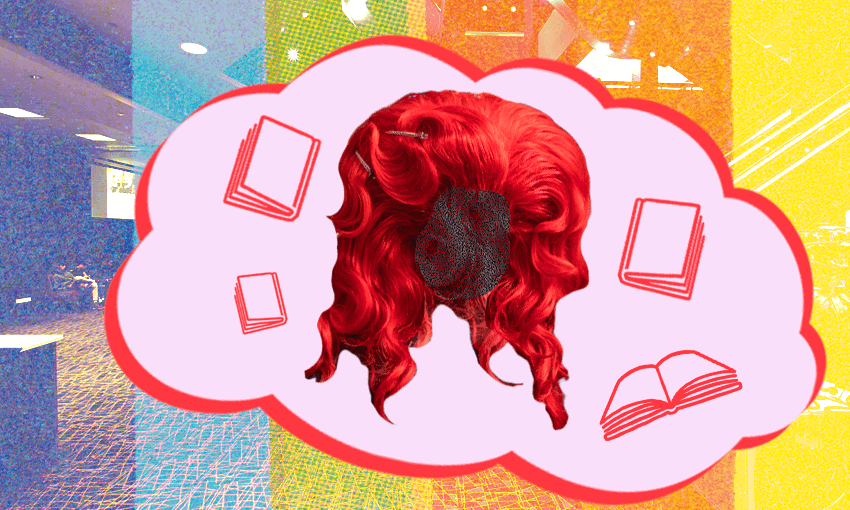The controversy around drag performers reading to children arrived in Auckland last week. Sam Brooks presents the reality behind the controversy.
Avondale Library had to close briefly last week after protestors interrupted a drag performer’s storytime session, leading to police intervention. The event, a part of Pride Fest Out West, involved the acclaimed drag queen Medulla Oblongata performing songs and reading stories to children.
It follows a string of similar protests in the US, which come amid increasingly aggravated commentary accusing drag performers of being “groomers”, and equating these events to promoting paedophilia. Just last week, Tennessee became the first state in the United States to write restrictions around drag performances into law.
Darryl Soljan, the head of community delivery for North and West Auckland at Auckland Council, says drag storytimes are no different than any other story performances delivered by library staff and guests. “An engaging entertainer with excellent storytelling skills reads fantastic age-appropriate books to children and families,” he explains. “The main differences with Drag Storytimes are that the books cover topics that specifically promote acceptance, inclusion and valuing the difference in others. And that the costumes are particularly bright and fabulous!”
These storytimes are usually held during Auckland Pride Month, and are some of the libraries’ most popular storytelling events. “Parents and caregivers tell us that drag storytimes help their children understand that everyone should be celebrated for being whoever they choose to be, even if they might seem different,” says Soljan.
“Interestingly, adults seem to see those ‘differences’ a lot more than young people.”
Hugo Grrrl, the winner of House of Drag season one and the co-creator of the hugely successful Glitter Garden, a drag show aimed at children, is a veteran of events like Drag Storytime. “Drag specialises in great, fun, interactive aesthetics to tell stories,” he says, “It’s exaggerated, it’s cartoonish, it’s perfect for children.”
Grrl will start one of these sessions by greeting people at the door as a way to break the ice. “I’ll wear a head-to-toe suit and some big silly hair, but often that’s quite intimidating,” he says. “So I’ll crouch down and get on the kids’ level as they arrive, to break the ice and show them that I’m a friendly human being in addition to being an awesome-looking human being.” (Grrrl also dresses in as many sequins and sparkles as possible because “kids love glitter”.)
After that, everybody sits around – parents and children altogether – and they sing songs and read books. One of Grrrl’s favourite sessions to do is an animal-themed session. “I’ll read four to five children’s books that are all about animals, because those stories tend to have clear and amazing metaphors for being different.”
Grrrl dismisses the criticisms of Drag Storytime as being inappropriate for children because drag performers are traditionally seen as performing in a nightclub setting. “You imagine an actor, the kinds of actors who’ve done children’s plays. Not all the work that actor does will be child-friendly, but they’re still an amazing performer and that skillset lends itself to entertaining children,” he says. “But in addition to that, they do some grown-up plays that would absolutely not be suitable for children.”
“It’s the same thing with drag, right? A lot of the form is not suited to children, and of course parents should not bring their children to those shows, just in the same way they shouldn’t bring their kids to R18 movies.”
View this post on Instagram
Libraries are, of course, about more than just books. They’re community hubs that provide access to information, they’re places of learning, and places to ask for and receive help. They are also, crucially, one of the few remaining places that welcome anybody, regardless of their position in society. Millionaires enters the library no different than the penniless.
Soljan and his team want everyone to feel that libraries are a space for them. “They belong to all of us equally. As a library service, it is our responsibility to invite, celebrate and take action to clearly include marginalised communities,” he says. These events demonstrate, clearly but not forcefully, that queer people belong in the library, whether as staff or as community.
Beyond that, Drag Storytime is also a conversation starter about identity and belonging at a community level – where honest and open kōrero about gender, about family, about difference can be sparked.“It’s essential that our communities have places to open these conversations and connect, especially when beliefs, opinions and experiences can differ,” says Soljan.
“On the most noticeable level, Drag Storytime is an act of joyful celebration, a welcoming rainbow path through the shelves.”
Grrrl sums it up succinctly: “All we’re about is teaching kids that it is cool to be different and diverse. That’s valuable messaging for literally every young human on the planet.”



